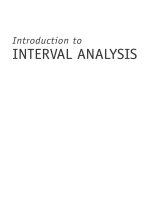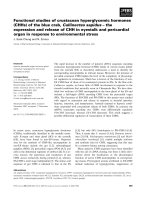INTRODUCTION TO ENVIRONMENTAL MONITORING
Bạn đang xem bản rút gọn của tài liệu. Xem và tải ngay bản đầy đủ của tài liệu tại đây (800.38 KB, 36 trang )
INTRODUCTION TO
ENVIRONMENTAL
MONITORING
Introduction to Environmental Science in the
1
Lesson Learning Goals
At the end of this lesson you should be able to:
Discuss the application of monitoring in
assessing ecosystem health
Differentiate among monitoring program types
and objectives
Describe a generic monitoring framework
Explain the different investigative tools
available in undertaking a monitoring program
Introduction to Environmental Science in the
2
Environmental Monitoring
Environmental monitoring is a tool for
detecting improvements or
degradation in the health of
ecosystems
Monitoring is conducted
to
assess the status of the
environment and to protect against
potential damage by human activities
such as industrial waste disposal or
logging
Introduction to Environmental Science in the
3
Environmental Monitoring
Defined
EIA monitoring is the planned,
systematic collection of
environmental data to meet
specific objectives and
environmental needs
Introduction to Environmental Science in the
4
Benefits of Monitoring
Monitoring combined with enforcement ensures
proper functioning of environmental protection
measures (EPMs) prescribed for development
projects or activities
Monitoring allows the early identification of
potentially significant effects (i.e., early trends
which could become serious)
Through assuring compliance in a cost-effective
manner, monitoring contributes to optimize
economic-cum-environmental development
benefits
Introduction to Environmental Science in the
5
The Cost of Monitoring
A
B C
Total Project Budget = Entire Circle
Environmental Impact Assessment =
Sector A - C
Monitoring = Sector B - C
Introduction to Environmental Science in the
6
Cost Effectiveness
Project
Monitoring
Program
EPMs
Unanticipated Benefit / Cost
Implemented Adverse Effects
Ratio
A
NO
YES
NO
1.5
25 %
B
NO
YES
YES
1.0
25 %
C
NO
NO
NO
1.0
25 %
D
NO
NO
YES
0.5
25 %
E
YES
YES
NO
1.45
50 %
F
YES
YES
YES
1.25
50 %
Probability
SUMMARY
Project without monitoring: Benefit/Cost Average = 1.0
Project with Monitoring: Benefit/Cost Average = 1.35
Introduction to Environmental Science in the
7
Costs of Not Monitoring
Economic Consequences - correcting
problems after environmental
degradation has occurred is ultimately
more costly than monitoring and preemptive measures
Social Consequences - public health
issues can develop
Political Consequences - government
agencies and officials may be the
target of public opposition and anger
Introduction to Environmental Science in the
8
Monitoring Program
Objectives
Document baseline conditions
Review the accuracy of impact predictions
Review activities and/or mitigation
measures
Monitor compliance with agreed conditions
Identify trends in impacts
Assess the effectiveness of environmental
protection measures and management
regulations
Introduction to Environmental Science in the
9
Purpose of Baseline
Monitoring
To gather information about a receiving
environment which is potentially at risk from a
proposed development project or activity
To identify valued ecosystem components
(VEC) in the receiving environment and assess
potential threats to these components
Information gathered on existing conditions
provides a baseline for subsequently
assessing post-development changes
Introduction to Environmental Science in the
10
Purpose of Compliance and
Environmental Effects
Monitoring
Recognize environmental changes (i.e., from
baseline conditions) and analyze causes
Measure adverse impacts and compare with
predicted impacts
Evaluate and improve mitigation measures
Detect short-term and long-term trends to
assess the protectiveness of existing standards
Improve practices and procedures for
environmental management and assessment
Introduction to Environmental Science in the
11
Generic Monitoring
Framework
Effective monitoring requires prior thought to
expectations and goals, and the development
of specific questions to be answered and
methods of testing those questions
Adoption of a rigorous framework in designing
and conducting a monitoring program will
ensure that resulting management decisions or
policy choices are less likely to be
controversial and more likely to be accepted
by interested parties (e.g., industry, the public)
Introduction to Environmental Science in the
12
Refine
Phase I
Background
Define requirements
and goals
Review existing
Information
Goals addressed?
Phase II
Design/Planning
Develop monitoring
Strategy
Develop
sampling design
Develop QA/QC
procedures
Design meet objectives?
Phase III
Implementation
Conduct pilot
Studies
Apply QA/QC
procedures
Conduct monitoring
program
Data quality acceptable?
Phase IV
Analysis/Report
Analyze &
interpret data
Present results
& conclusions
Objectives achieved?
Phase V
Follow-up
Disseminate
information
Make
Decisions
Refine or end
monitoring program
Introduction to Environmental Science in the
13
End
Phase I – Defining Monitoring
Objectives and Goals
Managers
Objectives
Expectations
How information
will be used to
make decisions
Scientists
Are objectives
and expectations
achievable?
What is realistic?
Introduction to Environmental Science in the
14
Transition to Phase II
Need to evaluate question:
Do technical objectives address
requirements and goals of
managers?
If no, then you need to revisit Phase I
If yes, then proceed to Phase II
Introduction to Environmental Science in the
15
Phase II – Rationale
Lack of proper planning can result in:
Omission of important environmental variables
Data do not address objectives
Data of low statistical value
Failure to detect existing
contamination/environmental effects
Data incapable of answering research question
Introduction to Environmental Science in the
16
Monitoring Strategy
First steps are the identification and
preliminary characterization of
stressors, the ecosystem potentially at
risk, and possible ecological effects
Stressors are contaminants of concern
such as chemicals or physical changes
that may impact on ecosystems
Resources at risk are VECs found in
close and prolonged proximity to
stressors which could be adversely
affected through exposure
Introduction to Environmental Science in the
17
Monitoring Strategy
(Cont’d)
A conceptual model is then developed to
provide a qualitative description of how the
various ecological components co-occur and
contact the stressors; the model helps
define possible exposure-effect scenarios
The type of responses expected from
exposure to the stressor(s) will guide
sampling design and selection of
measurement variables
Predicted responses must be clearly stated
as testable questions to be answered by the
monitoring program
Introduction to Environmental Science in the
18
Setting Appropriate
Boundaries
Boundaries determine the type of
questions which can be answered by a
monitoring program:
» Administrative (e.g., political, social, economic)
» Temporal and spatial
» Ecological (i.e., derived from physical, chemical
and biological processes)
» Technical (e.g., limitations of methods or
sampling and analytical equipment)
Introduction to Environmental Science in the
19
Measurement Variables
It is prohibitively expensive, if not
impossible, to monitor every contaminant
and ecosystem component; criteria for
prioritizing measurement variables include:
» Relevance
» Consideration of indirect effects and factors
affecting bioavailability and/or response
» Sensitivity and response time
» Variability (i.e., signal-to-noise ratio)
» Practical issues (e.g., cost, ease of
measurement)
Introduction to Environmental Science in the
20
Chemical Variables –
General
Comments
Function
measures exposure,
not effects
contaminants
modifiers
nutrients
can compare to
standards or criteria
high cost
Introduction to Environmental Science in the
21
hemical Variables – Water Colum
Comments
Function
measure of
contamination
can include
modifiers (e.g.,
salinity, pH)
can include
measures of
enrichment
(e.g. C,N,P)
extensive database
on toxicity/risk of
effects for
comparison
preferred medium for
soluble contaminants
variable temporally
(i.e., requires high
frequency of
measurement)
Introduction to Environmental Science in the
22
Physical Variables
Comments
Function
can be stressors
(e.g.,
suspended
sediments or
deposited
solids)
can be
modifiers (e.g.,
temperature,
sediment grain
size)
limited data
available on risk of
physical alterations
useful for data
analysis and
interpretation
low cost
variable
measurement
frequent required
Introduction to Environmental Science in the
23
Biological Variables –
General
Comments
Function
direct
measurements
of effects in the
real world (i.e.,
not relying on
literature data or
laboratory data)
confounding
factors can make
results
interpretation
difficult
high cost
low measurement
frequency
Introduction to Environmental Science in the
24
Biological Variables – Fish
Comments
Function
measure effects
at many levels
(i.e.,
community,
population,
organism,
tissue, cellular)
important
socially
long history in
monitoring
scale may be too broad
depending on species of
concern
generally sensitive to
enrichment,
contaminants and
physical alteration
high cost; low frequency
Introduction to Environmental Science in the
25









